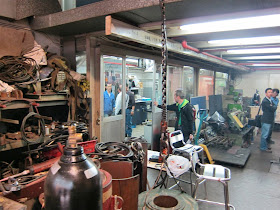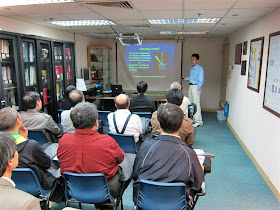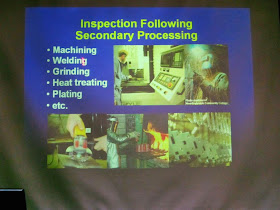AES® was founded in 1983. Besides rendering DT and NDT services, it now also provides services such as Calibration of Instruments, Welding Procedure and Welder Qualification Test, Proof Load Test of Structural Fixing and Masonry, Proof Load Test of Lifting Appliances and Lifting Gear, NDT personnel and Welding Inspector Training, etc.

In the beginning, Mr. K.W. Wong (Executive Director) and Dr. Welkin Li (Technical Director) led us to visit the testing site.

Mr. Wong showed the specimen for tensile testing and explained the requirement to us.

Then AES professional demonstrated the tensile testing operation.

After the specimen broken, Young's Modulus was calculated by computer.


The second test demonstration was Impact testing. The specimen was showed and it should be passed the Go-No-Go gauge before test.

Impact tester

The last test was hardness test.


After the demonstration, Mr. Wong introduced the most common Non-Destructive Test (NDT) Methods and its applications.

There were many NDT methods.

The five most common NDT Methods were “Liquid Penetrant”, “Magnetic”, “Ultrasonic”, “Eddy Current” and “X-ray”.

Liquid Penetrant Inspection used a fluorescent dye and then inspection was done under UV light.

Magnetic Particle Inspection using finely milled iron particles coated with a dye pigment are then applied to the specimen.

Ultrasonic Inspection (Pulse-Echo) used high frequency sound waves which were introduced into a material and they were reflected back from surfaces or flaws.

Eddy Current Testing used electromagnetic induction to detect flaws in conductive materials.

X-ray Film Radiography used for NDT. Thicker and more dense area would stop more or the radiation.

There were three common application of NDT below.
Inspection of Raw Products

Inspection Following Secondary Processing

Inspection for In-Service Damage

Then Mr. Wong said pipeline inspection was also one of their services.

After described different NTD method, Mr. Wong introduced the qualification of NDT personal.

ASNT Level I, II & III

Welding Inspection Personnel Qualification

Moreover, Mr. Wong explained the business model of NTD to us.

The overall flow chart was mentioned.

NDT Follow Chart was briefed.

Finally, Mr. Wong said to have a high quality work, you must get enough money. It was because “Higher quality needs higher investment”. Moreover, he concluded the four points to have good quality control of welding below:
· Adequate resources and financial support
· Independent third party inspection system
· Importance of Certified Welding Inspector (CWI) in welding project
· Appropriate Quality Assurance Control Procedure Non-Destructive Testing
Q&A Session

We took a group photo in front of AES.

Reference:
AES Destructive and Non-Destructive Testing Ltd. – http://www.aes.hk/

沒有留言:
發佈留言